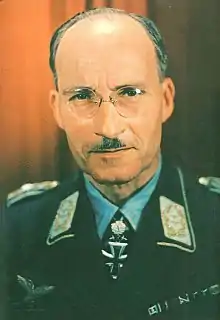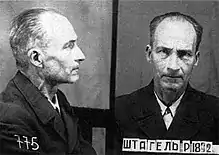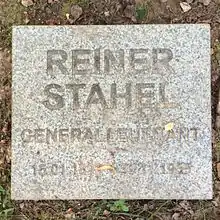Reiner Stahel
Reiner Stahel, (15 January 1892 – 30 November 1955) was a German officer and a member of the Nazi Party. He is best known for his retreat from Vilna and the command of the garrison of Warsaw during the Warsaw Uprising of 1944. Arrested by the NKVD in Romania, he spent the rest of his life in Soviet captivity.
Reiner Stahel | |
|---|---|
 Rainer Stahel in uniform. | |
| Born | 15 January 1892 Bielefeld, German Empire |
| Died | 30 November 1955 (aged 63) Ivanovo, Russian SFSR, Soviet Union |
| Allegiance | |
| Service/ | Army |
| Years of service | 1914–1945 |
| Rank | Generalleutnant |
| Battles/wars | World War I Finnish Civil War World War II |
| Awards | Knight's Cross of the Iron Cross with Oak Leaves and Swords |
Career
Born in Bielefeld, Stahel joined the German Army during World War I. By the end of the war he had moved to Finland and joined the Finnish Army participating in the Finnish Civil War. In 1933 he went to Nazi Germany where he worked at the Ministry of Aviation.
Stahel participated in the German invasion of the Soviet-Union as commander of Flakregiments 34 (June 1941), Flakregiment 99 (April 1942) and 4th Luftwaffe Field Division (September 1942). During the Battle of Stalingrad, Stahel conducted defensive actions at the head of Kampfgruppe Stahel. On 21 January 1943, he was promoted to Major General and then transferred to Air Fleet 4.
At the end of May 1943, he was appointed commander of the new 22nd Flak Brigade in Italy and entrusted with the protection of the Strait of Messina. Following the German retreat from Sicily and Italy's surrender, Stahel was made the military commander of the city of Rome in September 1943.
In July 1944 he was transferred to Vilnius in German-occupied Poland (currently Lithuania), where he became the military commander of the garrison. Initially commanding roughly 500 men, soon he received reinforcements and was able to postpone the seizure of that city by Polish partisans and the Red Army. For his efforts, on 28 July 1944, he was awarded the Swords to the Knight's Cross and promoted to the rank of lieutenant general.

Stahel was transferred to Warsaw, where he was to defend the city against the advancing Red Army.[1] However, the Soviet offensive was halted and instead on 1 August the Warsaw Uprising was started by the Polish Home Army. On the first day of the uprising Stahel was surrounded in his headquarters in the Saxon Palace, and he lost control of the situation.[1] On 4 August the command over Nazi forces in Warsaw was given to Waffen-SS commander Erich von dem Bach and Stahel's pocket was subordinated to the new commander. Although by 7 August the troops of Oskar Dirlewanger managed to reach Stahel's positions in the city centre, he did not resume his command over the city's garrison. Instead, on 24 August he was dispatched to Bucharest, where similar urban fighting was anticipated by the German headquarters; his troops attempted to occupy Bucharest on 24 August, the capital of the country, but they were repulsed by troops loyal to King Michael I. Over this and the coming days Romania switched sides and the Red Army entered the city almost unopposed.

On 20 September 1944, Stahel was arrested by the NKVD together with Field Marshal Ion Antonescu. Interrogated on his part in the Warsaw Uprising, he was imprisoned in the Soviet Union. The exact date of his death is a subject of controversy. According to Soviet sources Stahel died on 30 November 1952, in Vladimir central transfer prison. However, other sources mention that Stahel died in 1955 in the Voikovo officer prison camp of a heart attack when he was informed of his possible transfer to Germany.
Suppression of Warsaw uprising
Despite his relatively limited role in suppressing the Warsaw uprising of 1944 Stahel was responsible for a series of crimes committed against the civilian population of Warsaw. On 2 August he ordered the killing of all men identified as actual or potential insurgents, and the taking of hostages from among the civilian population to be used as human shields when assaulting insurgent positions.[2] The testimonies of the soldiers of 4. East Prussian Grenadier Regiment of the 562nd Grenadier Division who arrived in Warsaw on 3 August show that Stahel gave them the order to "kill all men encountered, remove women and children, and burn houses."[3] Moreover, Stahel ordered the execution of Polish prisoners held in prison on Rakowiecka street in Mokotów district[4] and officially sanctioned looting perpetrated by German soldiers, allowing them to take anything they wanted from houses on fire.[5]
Awards
- Iron Cross (1914) 2nd Class (12 October 1914) & 1st Class (24 March 1915)[6]
- Iron Cross (1939) 2nd Class (16 July 1941) & 1st Class (18 September 1941)[6]
- Knight's Cross of the Iron Cross with Oak Leaves and Swords
- Knight's Cross on 18 January 1942 as Oberstleutnant and commander of Flak-Regiment 34.[7]
- Oak Leaves on 4 January 1943 as Oberst and commander of a Luftwaffe-Kampfgruppe "Stahel"[7]
- Swords on 18 July 1944 as Generalmajor and commander of Fester Platz Wilna[8]
References
Citations
- Władysław Bartoszewski; Muzeum Powstania Warszawskiego. Dni walczącej stolicy : kronika Powstania Warszawskiego (in Polish). Warszawa: Muzeum Powstania Warszawskiego, Świat Książki. ISBN 978-83-7391-679-1.
- Antoni Przygoński, Powstanie warszawskie w sierpniu 1944, Warszawa: Państwowe Wydawnictwo Naukowe, 1988, page 241.
- Adam Borkiewicz, Powstanie warszawskie 1944: zarys działań natury wojskowej, Warszawa: PAX, 1962., page 108
- Lesław M. Bartelski, Mokotów 1944, Warszawa: Wydawnictwo MON, 1971, page 277.
- Protokół przesłuchania komendanta garnizonu Warszawa gen. Reinera Stahela, Moscow: 25/08/1945 r., http://ipn.gov.pl/portal/pl/719/10337/Nieznane_dokumenty_z_Powstania_Warszawskiego.html.
- Thomas 1998, p. 340.
- Scherzer 2007, p. 716.
- Fellgiebel 2000, p. 44.
Bibliography
- Scherzer, Veit (2007). Die Ritterkreuzträger 1939–1945 Die Inhaber des Ritterkreuzes des Eisernen Kreuzes 1939 von Heer, Luftwaffe, Kriegsmarine, Waffen-SS, Volkssturm sowie mit Deutschland verbündeter Streitkräfte nach den Unterlagen des Bundesarchives [The Knight's Cross Bearers 1939–1945 The Holders of the Knight's Cross of the Iron Cross 1939 by Army, Air Force, Navy, Waffen-SS, Volkssturm and Allied Forces with Germany According to the Documents of the Federal Archives] (in German). Jena, Germany: Scherzers Militaer-Verlag. ISBN 978-3-938845-17-2.
- Thomas, Franz (1998). Die Eichenlaubträger 1939–1945 Band 2: L–Z [The Oak Leaves Bearers 1939–1945 Volume 2: L–Z] (in German). Osnabrück, Germany: Biblio-Verlag. ISBN 978-3-7648-2300-9.